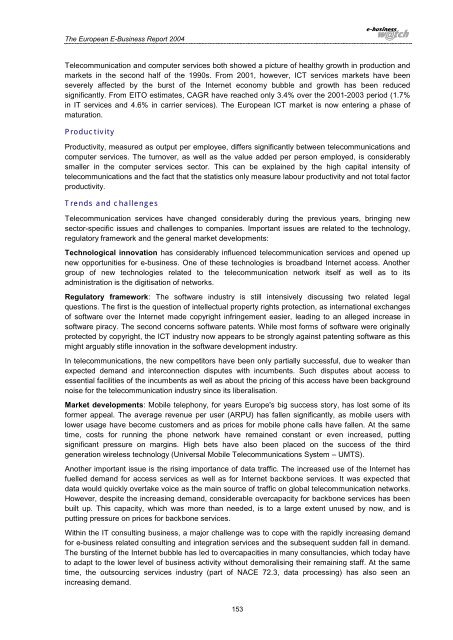The European e-Business Report 2004 - Berlecon Research GmbH
The European e-Business Report 2004 - Berlecon Research GmbH
The European e-Business Report 2004 - Berlecon Research GmbH
Create successful ePaper yourself
Turn your PDF publications into a flip-book with our unique Google optimized e-Paper software.
<strong>The</strong> <strong>European</strong> E-<strong>Business</strong> <strong>Report</strong> <strong>2004</strong>Telecommunication and computer services both showed a picture of healthy growth in production andmarkets in the second half of the 1990s. From 2001, however, ICT services markets have beenseverely affected by the burst of the Internet economy bubble and growth has been reducedsignificantly. From EITO estimates, CAGR have reached only 3.4% over the 2001-2003 period (1.7%in IT services and 4.6% in carrier services). <strong>The</strong> <strong>European</strong> ICT market is now entering a phase ofmaturation.ProductivityProductivity, measured as output per employee, differs significantly between telecommunications andcomputer services. <strong>The</strong> turnover, as well as the value added per person employed, is considerablysmaller in the computer services sector. This can be explained by the high capital intensity oftelecommunications and the fact that the statistics only measure labour productivity and not total factorproductivity.Trends and challengesTelecommunication services have changed considerably during the previous years, bringing newsector-specific issues and challenges to companies. Important issues are related to the technology,regulatory framework and the general market developments:Technological innovation has considerably influenced telecommunication services and opened upnew opportunities for e-business. One of these technologies is broadband Internet access. Anothergroup of new technologies related to the telecommunication network itself as well as to itsadministration is the digitisation of networks.Regulatory framework: <strong>The</strong> software industry is still intensively discussing two related legalquestions. <strong>The</strong> first is the question of intellectual property rights protection, as international exchangesof software over the Internet made copyright infringement easier, leading to an alleged increase insoftware piracy. <strong>The</strong> second concerns software patents. While most forms of software were originallyprotected by copyright, the ICT industry now appears to be strongly against patenting software as thismight arguably stifle innovation in the software development industry.In telecommunications, the new competitors have been only partially successful, due to weaker thanexpected demand and interconnection disputes with incumbents. Such disputes about access toessential facilities of the incumbents as well as about the pricing of this access have been backgroundnoise for the telecommunication industry since its liberalisation.Market developments: Mobile telephony, for years Europe's big success story, has lost some of itsformer appeal. <strong>The</strong> average revenue per user (ARPU) has fallen significantly, as mobile users withlower usage have become customers and as prices for mobile phone calls have fallen. At the sametime, costs for running the phone network have remained constant or even increased, puttingsignificant pressure on margins. High bets have also been placed on the success of the thirdgeneration wireless technology (Universal Mobile Telecommunications System – UMTS).Another important issue is the rising importance of data traffic. <strong>The</strong> increased use of the Internet hasfuelled demand for access services as well as for Internet backbone services. It was expected thatdata would quickly overtake voice as the main source of traffic on global telecommunication networks.However, despite the increasing demand, considerable overcapacity for backbone services has beenbuilt up. This capacity, which was more than needed, is to a large extent unused by now, and isputting pressure on prices for backbone services.Within the IT consulting business, a major challenge was to cope with the rapidly increasing demandfor e-business related consulting and integration services and the subsequent sudden fall in demand.<strong>The</strong> bursting of the Internet bubble has led to overcapacities in many consultancies, which today haveto adapt to the lower level of business activity without demoralising their remaining staff. At the sametime, the outsourcing services industry (part of NACE 72.3, data processing) has also seen anincreasing demand.153
















